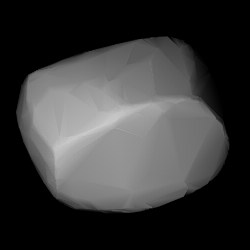
141 Lumen is a carbonaceous asteroid from the intermediate asteroid belt, approximately 130 kilometers in diameter. It is an identified Eunomian interloper.

23 Thalia is a large main-belt asteroid. It was discovered by J. R. Hind on December 15, 1852, at the private observatory of W. Bishop, located in Hyde Park, London, England. Bishop named it after Thalia, the Muse of comedy and pastoral poetry in Greek mythology.

56 Melete is a large and dark main belt asteroid. It is a rather unusual P-type asteroid, probably composed of organic rich silicates, carbon and anhydrous silicates, with possible internal water ice. The asteroid orbits the Sun with a period of 4.18 years.

67 Asia is a large main belt asteroid. It was discovered by English astronomer N. R. Pogson on April 17, 1861, from the Madras Observatory. Pogson chose the name to refer both to Asia, a Titaness in Greek mythology, and to the continent of Asia, because the asteroid was the first to be discovered from that continent.
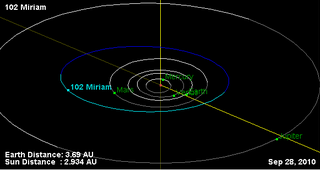
102 Miriam is a moderately large, very dark main belt asteroid. It was discovered by C. H. F. Peters on August 22, 1868, from the Litchfield Observatory.

112 Iphigenia is a fairly large and exceedingly dark main-belt asteroid. It is classified as a C-type asteroid, and therefore probably has a primitive carbonaceous composition. It was discovered by German-American astronomer C. H. F. Peters on September 19, 1870, and named after Iphigenia, a princess sacrificed by her father in Greek mythology. The orbital elements for 112 Iphigenia were published by German astronomer Friedrich Tietjen in 1871.

120 Lachesis is a large main-belt asteroid. It was discovered by French astronomer Alphonse Borrelly on April 10, 1872, and independently by German-American astronomer Christian Heinrich Friedrich Peters on April 11, 1872, then named after Lachesis, one of the Moirai, or Fates, in Greek mythology. A Lachesean occultation of a star occurred in 1999 and was confirmed visually by five observers and once photoelectrically, with the chords yielding an estimated elliptical cross-section of 184 × 144 km.

127 Johanna is a large, dark main-belt asteroid that was discovered by French astronomers Paul Henry and Prosper Henry on 5 November 1872, and is believed to be named after Joan of Arc. It is classified as a CX-type asteroid, indicating the spectrum shows properties of both a carbonaceous C-type asteroid and a metallic X-type asteroid.

147 Protogenia is a large main belt asteroid that was discovered by Hungarian astronomer Lipót Schulhof on July 10, 1875, from the Vienna Observatory; it was his only asteroid discovery. Its name is Greek for "first born" and was chosen by Karl L. Littrow in allusion to the fact that this was the first asteroid discovered by an astronomer who was already known for work in other fields of astronomy.

152 Atala is a large main belt asteroid that was discovered by brothers Paul Henry and Prosper Henry on 2 November 1875, but the discovery was credited to Paul. It is a type D asteroid, meaning that it is composed of carbon, organic rich silicates and possibly water ice.
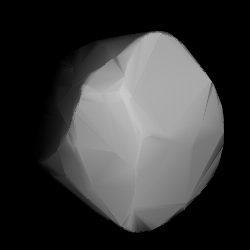
154 Bertha is a main-belt asteroid. It was discovered by the French brothers Paul Henry and Prosper Henry on 4 November 1875, but the credit for the discovery was given to Prosper. It is probably named after Berthe Martin-Flammarion, sister of the astronomer Camille Flammarion.

168 Sibylla is a large main-belt asteroid, discovered by Canadian-American astronomer J. C. Watson on September 28, 1876. It was most likely named for the Sibyls, referring to the Ancient Greek female oracles. Based upon its spectrum this object is classified as a C-type asteroid, which indicates it is very dark and composed of primitive carbonaceous materials. 168 Sibylla is a Cybele asteroid, orbiting beyond most of the main-belt asteroids.

196 Philomela is a large and bright main-belt asteroid. It is an S-type asteroid.
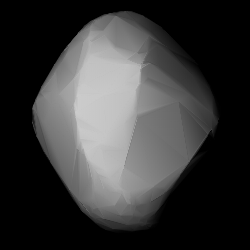
212 Medea is a very large main-belt asteroid that was discovered by Johann Palisa on February 6, 1880, in Pola, and was named after Medea, a figure in Greek mythology.

221 Eos is a large main-belt asteroid that was discovered by Austrian astronomer Johann Palisa on January 18, 1882, in Vienna. In 1884, it was named after Eos, the Greek goddess of the dawn, to honour the opening of a new observatory that was hoped to bring about a new dawn for Viennese astronomy.
234 Barbara is a main belt asteroid that was discovered by German-American astronomer Christian Heinrich Friedrich Peters on August 12, 1883, in Clinton, New York. The object is orbiting the Sun with a semimajor axis of 2.385 AU, a period of 3.68 years, and an eccentricity of 0.25. The orbital plane is inclined by 15.37° to the plane of the ecliptic. It is classified as a stony S-type asteroid based upon its spectrum. The mean diameter of this object is estimated as 45.6 km. It has a rotation rate of 26.5 hours, or a little over a day. It is possibly named for Saint Barbara, patron saint of mathematicians.
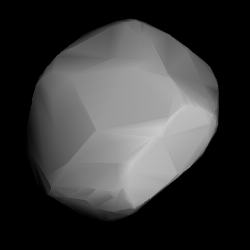
238 Hypatia is a large main-belt asteroid that was discovered by Russian astronomer Viktor Knorre on July 1, 1884, in Berlin. It was the third of his four asteroid discoveries. The name was given in honour of philosopher Hypatia of Alexandria. Based upon the spectrum, it is classified as a C-type asteroid and is probably composed of primitive carbonaceous material. Like many asteroids of this type, its surface is very dark in colour.

365 Corduba is a very large main-belt asteroid that was discovered by the French astronomer Auguste Charlois on 21 March 1893 from Nice. It is classified as a C-type asteroid and is probably composed of carbonaceous material.
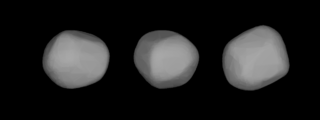
423 Diotima is one of the larger main-belt asteroids. It is classified as a C-type asteroid and is probably composed of primitive carbonaceous material.
650 Amalasuntha is a minor planet orbiting the Sun that was discovered by German astronomer August Kopff on October 4, 1907, at Heidelberg. It was named after Amalasuntha, the queen of the Ostrogoths from 526 to 534 AD. The name may have been inspired by the asteroid's provisional designation 1907 AM.
